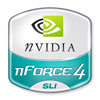nForce4 Variants
| Variant | Socket | PCI Express | Firewall | SATA | USB |
 |
Socket 754 (Athlon 64, Sempron) | 20 lanes, PEG16X, 4 x 1X | Software | SATA150 | 10 ports |
 |
Socket 939 (Athlon 64, Athlon FX) | 20 lanes, PEG16X, 4 x 1X | Hardware | SATA300 | 10 ports |
 |
Socket 939 (Athlon 64, Athlon FX) | 20 lanes, 2 x PEG16X (8/8 split), 4 x 1X | Hardware | SATA300 | 10 ports |
The main differentiating work goes on with the budget version. The SATA controller still supports 4 ports and all the features of the controller I outlined earlier, but the host clock is 1500MHz, so you're limited to SATA150 support instead of SATA300. That I can understand on the base version where high performance disks supporting the standard aren't likely to be used.
However you only only get a software firewall on the basic version, for reasons that only make financial sense, rather than common sense. Vendors save money buying the slightly crippled base nForce4 part from NVIDIA, but the firewall is run on the CPU instead of the core logic. For those cheaper boxes, that also means slower CPUs, exactly those that would benefit most from CPU offload by a hardware firewall.
The Ultra and SLI versions only differ in the number of PEG16X graphics cards they support, with the Ultra obviously supporting two and the SLI only one. Only joking. Two for SLI, one for the Ultra.
In terms of CPU support, you need Socket 939 if you want the hardware firewall and SATA300 support. No big deal for the newcomer to the platform, but for the user with a nice Socket 754 CPU, they'll be more than a little annoyed at the product split.
The core logic also supports ten USB2.0 ports across all versions. They don't all have dedicated bandwidth and it's not clear why they've given the bridge two more ports than nForce3 250 (who's connecting ten USB devices to their PC when you can't even connect them to a hub?), but ten it is.
Ultimately, if you're looking to jump to Socket 939 now that it supports PCI Express, or you already have a Socket 939 CPU and want to jump, then great, there's an nForce4 variant for you that should be very attractive. If I were a Socket 754 CPU owner, or wanted to get in on the act with cheap Socket 754 CPUs, I'd decry the lack of hardware firewall support.
However the firewall is present, CPU based on not, and it's free and easy to use, adding value and protection for the user. Four port native SATA across the board sweetens the deal and all three bridge variants look like a nice place to park whatever supported CPU you have, should you have your heart set on PCI Express graphics and a Socket 754 or Socket 939 AMD CPU.
And much like nForce3, there's a whole load of software applications that help define the nForce4 'experience', for want of a better word.









